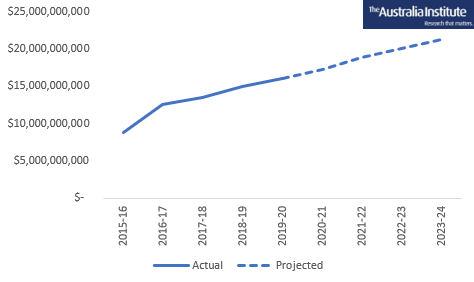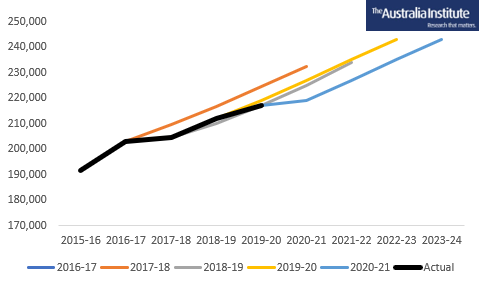Aged care
With aged care at the centre of the COVID-19 crisis and a scathing Royal Commission, the Government has been quick to claim “record investment” in the sector. And it is true – spending on residential and home care packages has been growing year on year as the population ages. But it is not clear that this Budget has gone anywhere beyond trend growth, as shown in Figure 1 below:

Without an increase in spending beyond the basic increase in the demands of the sector, it is hard to see how the problems of the aged care sector will be solved.
Another problem in the aged care budget is reduced transparency. Until 2017-18, budget papers accounted for residential care and home care in separate line items. Now they are combined into one, masking what is really going on. We have noted before that claims of increased support for one seem to come at the expense of the other.
This is particularly problematic when the Government’s targets and achievements in residential and home care package numbers show very different trends. Each year the Budget tends to be overly optimistic in targets for numbers of residential aged care places provided, with targets nearly always missed, as shown in Figure 2 below:

The thick black line in Figure 2 is the actual number of places provided, usually lower than the coloured forecast lines. By contrast, the number of home care packages delivered tends to exceed targets, as shown in Figure 3 below:

The thick black line again represents what has actually been delivered, consistently above the targets in the budget papers. Perhaps most interesting in the chart above is that while 23,000 extra home care packages are set to be funded, a number highlighted by the Government and picked up by the media, that number then literally flatlines for the rest of the budget period, as shown in the yellow line above.
It is hard to know what is going on here – the numbers of older Australians wanting to live at home for as long as possible is high and unlikely to decline according to Australia Institute research. It is unlikely that home care packages would remain at next years’ levels for the following three years.
All up, this Budget does not have a major boost for aged care, not beyond trend growth. In addition to financing, the quality of aged care needs to be improved through measures such as mandatory minimum staffing levels in residential facilities and integration of home share into the federal aged care system, something the Australia Institute has long advocated.